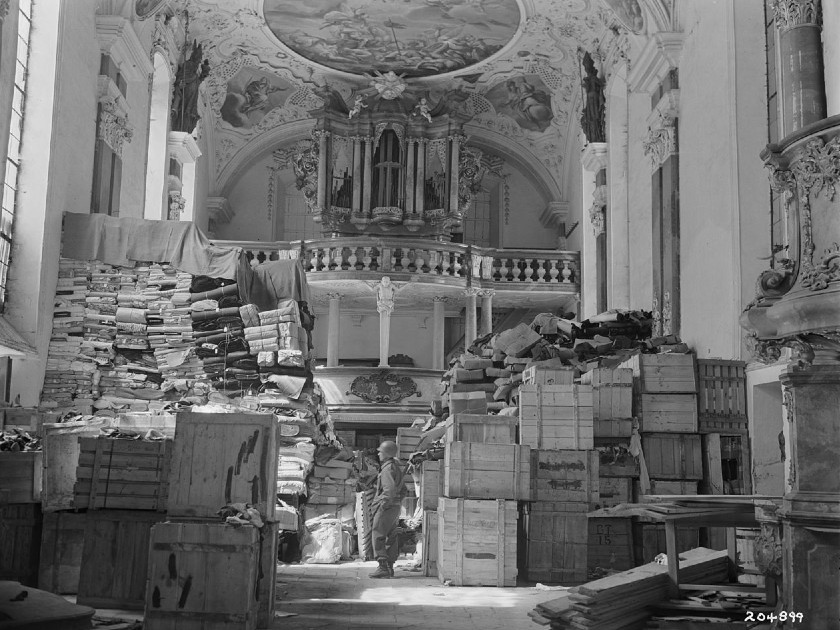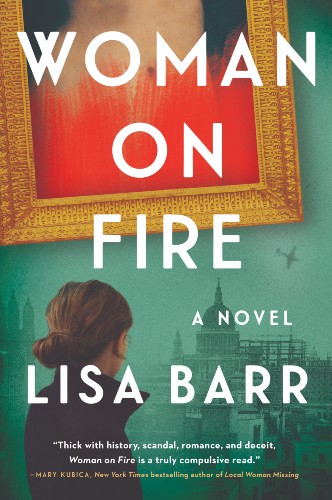
An American soldier stands amid Nazi looted art kept in the town of Ellingen, Germany, April 24, 1945
National Archives and Records Administration (NARA)
**Come hear Lisa Barr speak with James McAuley at our virtual Unpacking the Book event, Lisa Barr and James McAuley — Art, Assimilation, and Reclaiming a Stolen Legacy, which will be presented in partnership with the Jewish Museum and Tablet Magazine on Monday, April 11th at 7 PM ET–click here for free tickets!**
It was June 1991; back then I was a young journalist just out of graduate school. I was assigned by my editor at a women’s magazine to cover an exhibit at the Art Institute of Chicago called, “Degenerate Art: The Fate of the Avant-Garde in Nazi Germany.” When I walked into the museum, my breath caught in my throat and chills covered my arms; I knew I was not just reporting any story, I had found my story — the one that would forever change the course of my career and become a part of my soul. I would soon pivot from journalist to author and art lover, conducting obsessive research bent on exposing a topic that is still front-page news nearly eighty years after the Holocaust.
As a daughter of a Holocaust survivor, I never knew (until I explored the museum’s provocative exhibit of more than 150 works of Nazi-looted art) the intensity and sheer obsessiveness in which the Third Reich confiscated, destroyed, and plundered upwards of 600,000 works of art from private collections, museums, galleries, schools, and studios. It was a robbery on the grandest scale that began in Germany and spread to become an all-encompassing cultural pillaging of Europe’s treasures.
Hitler and his officials were determined to destroy those artists who did not comply with the Aryan ideal of art, particularly the avant-garde, including Cubists, Surrealists, Dadaists, Surrealists, and especially the German Expressionists who divided into two groups of artists—Die Brucke (The Bridge) and Der Blaue Reiter (The Blue Rider) — emerging in the early 1900s. Their works were forbidden because of their deeply provocative free-thinking style. And yet, it was no surprise that this passionate movement of art was celebrated and taking the rest of the world by storm.
Hitler’s attack on art was simple and fierce: destroy, steal, sell. Supply stores were shut down, galleries were boarded up, paintings were burned, museums were closed, teachers and curators were stripped of their jobs. Artists were subject to public ridicule and banned from exhibiting or selling their works. They were forbidden even from creating art inside the privacy of their own homes. Many artists were forced to hide, numerous artists committed suicide, and countless others were imprisoned and murdered.
Hitler’s attack on art was simple and fierce: destroy, steal, sell.
However, those paintings deemed valuable by the Nazi regime during their purge were held hostage. The Nazis took what they considered the best for themselves and sold major art anonymously by creating fake histories, and with the help of Switzerland. They funneled the immense profits of so-called “Degenerate Art” into the Nazi war machine.
Art was currency, art was control.
Hitler was determined to create a façade of legitimacy by fabricating an unimpeachable paper trail to show that many of these stolen works were sold to the Reich willingly. For example, in Nazi Germany, if families were put in concentration camps, their archives and provenance records were destroyed and replaced with fake documents and forced bills of sale. The Nazis also fabricated tax debts that were marked paid by the acquisition of the Jewish family’s art.
Decades later, the Nazis’ obsession with legal paperwork serves as integral evidence for the heirs of Holocaust victims who are seeking restitution of their family’s heirlooms, claiming that these sales were indeed forced, and that their relatives were coerced into giving up their artwork under extreme duress. And yet, certain countries and museums still cling to their stolen artwork by using the very same tactics that the Nazis themselves used to steal the paintings.
My new novel, Woman on Fire, was inspired by the Cornelius Gurlitt art scandal — known as “The Munich Art Hoard” — exposed in 2013. It sent shockwaves throughout the world. More than fifteen hundred major works of art worth approximately $1.5 billion were discovered hidden for nearly fifty years in the rundown Munich apartment of one Cornelius Gurlitt, who passed away in 2014 amid the scandal. His father was Hildebrand Gurlitt, one of Hitler’s four authorized dealers of Nazi-looted art. When he died, he bequeathed his massive treasure trove to his reclusive agoraphobic son who hid masterpieces in a food pantry, and even inside his stove. We’re talking the caliber of Picasso, Chagall, Cézanne, and Matisse. When I first read the exposé — again, I stopped in my tracks, chills rose along my arms — and I knew I had my story.
Sadly, it is a story that is ongoing, but there are rays of light. After years of investigation, the Fine Arts Museum of Bern, Switzerland, revealed this past December that it would “give up” nearly forty works of art (from the vast Gurlitt treasure that had been bequeathed to them in 2014 by Cornelius Gurlitt after he died). The museum’s investigators concluded that these paintings were indeed stolen by the Nazis or were of “questionable origin.” This big reveal gives hope to those seeking restitution, but it’s not enough …
I always say: If only art could talk … Thousands of Nazi-looted paintings are still out there, still being exhibited at revered museums, still hiding within the confines of major collections, still locked in years-long court battles between the heir and the collector who claims he/she purchased a painting in good faith, and those collectors who know the real history but chose to look the other way. If those masterpieces could speak — we would hear of a hidden, nefarious past eagerly waiting for the truth to be revealed.

Lisa Barr is The New York Times bestselling author of Woman on Fire, The Unbreakables, and the award-winning Fugitive Colors. She has served as an editor for The Jerusalem Post, managing editor of Today’s Chicago Woman and Moment magazine, and as an editor and reporter for the Chicago Sun-Times. She has appeared on Good Morning America and Today for her work as an author, journalist, and blogger. She lives in the Chicago area with her husband and three daughters.



